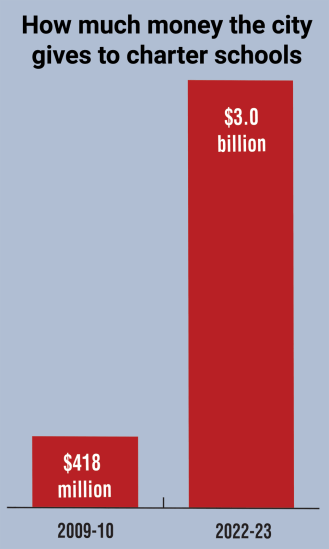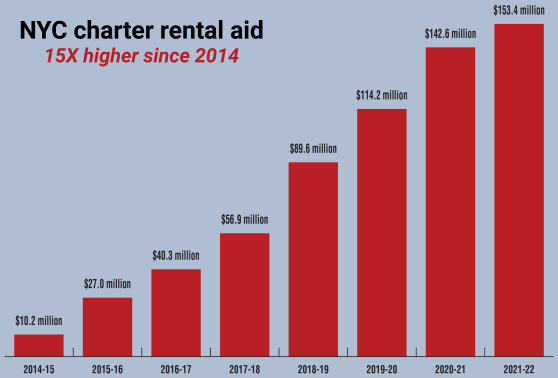
NYC plans to divert $3 billion to charter school in 2022-23 compared with $418 million in 2009-10
With aggressive marketing, strong lobbying, perks like free rent and millions of dollars of contributions from billionaire investors and philanthropists, the number of charter schools in New York City has expanded dramatically in the 24 years since the first New York City charter school opened in 1999.
It is a story of haves and have nots. Public money flowing to charter schools like Eva Moskowitz’s Success Academy — all on top of their donations from Wall Street — has come at the expense of public schools.
As of the 2022-23 school year, 142,500 students — nearly 15% of the total enrollment — attend one of 275 such schools that run parallel to the traditional public school system.
Success Academy, which opened its first school in 2006, has put the biggest stake in the ground: The publicly funded but privately run corporate chain has 47 schools across the city and about 21,000 students.
Now Gov. Kathy Hochul proposes to allow 106 more charter schools to open in New York City, setting off a battle in Albany this spring over charter school expansion.
“The unbridled expansion of the corporate-backed charter school sector, particularly Success Academy charter schools, in New York City is draining money, space and resources from our public schools and shortchanging our students,” UFT President Michael Mulgrew said.
The city’s public schools, whose enrollment declined 13.5% from a high of 1.04 million in the 2010-11 school year to 903,000 last fall, suffered $469 million in cuts for this school year, even as they deal with the academic and emotional toll of the COVID-19 pandemic on students and have had to serve about 6,000 newly arrived migrant students sent from Texas and Florida.
Meanwhile, the total amount of public funds that the city Department of Education provides to charter schools grew from $418 million in the 2009-10 school year to $3 billion this year.
Charter schools in New York City have a special perk that charters in the rest of the state do not have: New York City must provide charters with rent-free space in its public school buildings or pay for another space, under a 2014 state law foisted on then-Mayor Bill de Blasio, a charter school skeptic, by his nemesis, then-Gov. Andrew Cuomo.
Of the 275 charter schools in New York City, 128 are in DOE-owned or DOE-leased buildings and 147 are in non-DOE space, according to the New York City Charter School Center.
The rental aid the DOE pays for charter schools had grown to $153.4 million in the 2021-22 school year, 15 times higher than the $10.2 million it paid in 2014-15.
Success Academy has preferred co-locations in public school buildings as it expands. Her critics say Moskowitz has seized upon the proximity to public school families that co-locations provide as a marketing tool to spur demand for her more well-endowed schools.
In late 2022, the citywide Panel for Educational Policy approved two Success Academy co-locations, but Moskowitz hit a roadblock in January when the DOE withdrew proposals for three more co-locations that were fiercely opposed by the school communities.
New York City public schools have also been excluded from a pot of state funds that four other districts with high concentrations of charter schools have received every year since 2008, said Wendy Lecker, a senior attorney for the Education Law Center. That year, then-Mayor Michael Bloomberg supported state budget legislation that excluded the city DOE from access to this Charter School Transitional Aid. New York City public schools were “deprived of $2.6 billion in transitional aid from 2011 to 2022,” according to a March 2022 report from the Education Law Center.
“Not all school districts have such an explosion of charters, so there’s even more of an impact” on New York City, Lecker said.
Unlike public schools, there are no restrictions on charter school reserves, and their balances have been growing. Success Academy had $49.2 million in cash reserves, according to a 2021 financial statement, up from $4.4 million in 2015. That same year, it reported $121 million in unrestricted net assets, more than five times the $22 million in 2015. Success has received millions of dollars from hedge fund billionaires and other Wall Street supporters, including at elaborate fundraising galas. Hedge fund manager John Paulson and his wife, Jenny, gave $8.5 million to the chain in 2015. In 2022, Bloomberg announced a $100 million donation to Success Academy.
New York City charter schools have flexed their political muscle through powerful political action committees they and their allies created, such as New Yorkers for a Balanced Albany, New Yorkers for Putting Students First, Strong Leadership PAC and Moskowitz’s Great Public Schools PAC.
From 2020 to 2022, hedge fund manager Dan Loeb, a former Success Academy board chairman, gave a total of $1.4 million to those four PACs and his wife, Margaret, contributed $137,500.
“The whole charter school movement in New York City is backed by extremely wealthy people, many of them hedge fund managers who, for whatever reason, decided that this was their cause célèbre,” said Carol Burris, the executive director of the Network for Public Education.
With the millions of dollars they raise, charter school chains like Success can refurbish buildings and provide privileges and resources that are not available to public school students and schools.
“It creates a very inequitable system of schooling,” Burris said.
